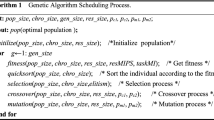Abstract
Resource scheduling has been one of the key challenges facing both academia and industry ever since the inauguration of cloud computing. Most of the existing research and practices have been focused on the maximization of the profits of cloud providers, whereas attention to the real needs of cloud users has largely been neglected. In this research, we propose a resource scheduling mechanism empowered with a relevance feedback network, which can be employed by a cloud provider to better meet a user’s resource needs. Our approach is a continuous refinement process that involves three stages: resource matching, resource selection, and feedback integration, where the feedback integration stage allows the resource scheduling history of a user to be considered to update the user’s resource demands and preference. The feedback information integrated in one cycle will effectively adjust the resource matching and selection in the next cycle. Incrementally, this mechanism will produce resource selections that are closer and closer to the user’s real needs. Simulation results indicated that this relevance feedback scheduling mechanism is very effective in satisfying users’ diverse requirements, and it also performs well in terms of the resource utilization rate from the cloud provider’s perspective.




Similar content being viewed by others
References
Foster I, Zhao Y, Raicu I, Lu SY (2008) Cloud computing and grid computing 360-degree compared. In: Proceedings of the Grid Computing Environments Workshop (GCE’08). New York: IEEE Press, pp 1–10
Armbrust M, Fox A, Griffith R, Joseph AD, Katz R, Konwinski A et al (2010) A view of cloud computing. Commun ACM 53(4):50–58
Mell P, Grance T (2009) The NIST Definition of Cloud Computing, Version 15. White Paper. V15
Google App Engine[EB/OL] (2008) http://appengine.google.com
Amazon Elastic Compute Cloud (EC2) [EB/OL] (2008) http://www.amazon.com/ec2/
Sims K (2009) IBM introduces ready-to-use cloud computing collaboration services get clients started with cloud computing [EB/OL]. http://www-03.ibm.com/press/us/en/pressrelease/22613.wss
Microsoft Azure [EB/OL] (2008) http://www.microsoft.com/azure/
Asvanund A, Krishnan R, Smith M, Telang R (2003) Interest-based self-organizing peer-to-peer networks: a club economics approach. In: Proceedings of the 13th Workshop on Information Technology and Systems
Crespo A, Garcia-Molina H (2005) Semantic overlay networks for P2P system. In: Proceedings of the 3rd Int’l Workshop on Agents and Peer-to-Peer Computing. Lecture Notes in Computer Science Volume 3601. pp 1–13
Smith S, Albaum G (2004) Fundamentals of marketing research. SAGE Publications, Thousand oaks
Rocchio JJ (1971) Relevance feedback in information retrieval. In: The smart retrieval system—Experiments in automatic document processing. Prentice Hall, Englewood Cliffs, pp 313–323
Eucalyptus [EB/OL] (2008) https://www.eucalyptus.com
OpenNebula Project[EB/OL (2008) http://www.opennebula.org
Nimbus [EB/OL] (2008) http://www.nimbusproject.org
Maheswaran M, Ali S, Siegel H, Hensgen D, Freund R (1999) Dynamic mapping of a class of independent tasks onto heterogeneous computing systems. J Parall Distrib Comp 59(2):30–44
Gu JH, Hu JH, Zhao TH, Sun GF (2012) A new resource scheduling strategy based on genetic algorithm in cloud computing environment. J Comp 7(1):42–52
Pandit D, Chattopadhyay S, Chattopadhyay M, Chaki N (2014) Resource allocation in cloud using simulated annealing. In: Proceedings of 2014 International Conference on Applications and Innovations in Mobile Computing (AIMoC’14). pp 21–27
Lu X, Gu ZL (2011) A load-adaptive cloud resource scheduling model based on ant colony algorithm. In: Proceedings of the 2011 IEEE International Conference on Cloud Computing and Intelligence Systems (CCIS’11). pp 296–300
Buyya R, Yeo CS, Venugopal S (2008) Market-oriented cloud computing: vision, hype, and reality for delivering IT services as computing utilities. In Proceedings of the 10th IEEE International Conference on High Performance Computing and Communications (HPCC’08). pp 5–13
Salehi MA, Buyya R (2010) Adapting market-oriented scheduling policies for cloud computing. Algorithms and Architectures for Parallel Processing. Lecture Notes in Computer Science Volume 6081. pp 351–362
Ding D, Luo SW, Ai LH (2012) An adaptive double auction mechanism for cloud resource allocation. J Commun 33(Z1):132–140 in chinese
Grover J, Katiyar S (2013) Agent based dynamic load balancing in Cloud Computing. In: Proceedings of 2013 International Conference on Human Computer Interactions (ICHCI). pp 1–6
Gupta S, Mittal A, Sharma A (2013) Multi-cloud computing environment with an agent based efficient scheduling method. In: Proceedings of the Second International Conference on Advances in Information Technology (AIT ’13). pp 92–95
Saaty TL (2008) Decision making with the analytic hierarchy process. Int J Serv Sci 1(1):83–98
Himani, Singh Sidhu H (2014) Comparative analysis of scheduling algorithms of Cloudsim in cloud computing. Int J Comp Appl 97(16):29–33
Ding D, Luo SW, Ai LH, Li YD (2012) A user preference driven approach for multi-QoS constrained task scheduling in grid. In: Proceedings of the 13th International Conference on Parallel and Distributed Computing, Application, and Technologies(PDCAT’12). Beijing, China: IEEE Computer Society. pp 493–498
Liu P (2012) Research of cloud resource allocation based on continuous double auction. East China Jiaotong University, Nanchang
Acknowledgments
This work is supported by National Nature Science Foundation of China (61300176), Fundamental Research Funds for the Central Universities (2013JBM019), Special Fund for Fast Sharing of Science Paper in Net Era by CSTD (2013113), Beijing Higher Education Young Elite Teacher Project (YETP0546) and China Scholarship Council (201307095016).
Author information
Authors and Affiliations
Corresponding author
Rights and permissions
About this article
Cite this article
Ding, D., Fan, X. & Luo, S. User-oriented cloud resource scheduling with feedback integration. J Supercomput 72, 3114–3135 (2016). https://doi.org/10.1007/s11227-015-1530-9
Published:
Issue Date:
DOI: https://doi.org/10.1007/s11227-015-1530-9




